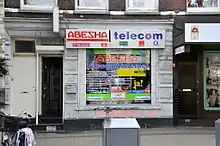Somalis in the Netherlands
Somalis in the Netherlands are residents or naturalized citizens of the Netherlands who are of Somali ancestry. They form one of the larger Somali communities in Europe.[3]
| Total population | |
|---|---|
| 34,631 (2013)[1] 0.21% of the Dutch population | |
| Regions with significant populations | |
| Languages | |
| Religion | |
| Islam |
Migration history
From 1989 to 1998, the Netherlands was the second-most common European destination for Somali asylum-seekers, only slightly behind the United Kingdom and more than double the total of the next-most common destination, Denmark.[3] However, between 2000 and 2005, there was a significant outflow of Somalis from the Netherlands to the United Kingdom, unofficially estimated to be as large as 20,000 people.The majority of the Somalis in Holland hail from Habar Gidir, Isaaq, Murusade, Abgaal and Xawaadle. According to the Somali community leader, Majority of the somali civilians living in the cities Amsterdam and Tilburg hail from the Xawaadle clan with Habar Gidir being majority in The Hague and Rotterdam. With Murusade being majority in Middelburg, Vlissingen and Delft. Abgaal are majority in cities such as Haarlem and Arnhem. Isaaq are majority in Utrecht and Lelystad [4] Factors mentioned as driving forces behind the exodus included an increase in opposition to Muslim immigration, as exemplified by the rise of Pim Fortuyn, Somali opposition to housing policies which forced them to live scattered in small groups all over various cities rather than in a larger agglomerated community,[4] a restrictive socio-economic environment which, among other things, made it difficult for new arrivals to find work,[5] and the comparative ease of starting a business and acquiring the means to get off social welfare in the UK.[4]
Demography

As of 2009, Statistics Netherlands estimated the following figures with respect to Dutch people of Somali origin:
- 15,281 persons of first-generation background (8,831 men, 6,850 women)
- 6,517 persons of second-generation background (3,322 men, 3,195 women), of which:
- 543 persons with one parent born in the Netherlands (273 men, 270 women)
- 5,974 persons with both parents born out of the Netherlands (3,049 men, 2,925 women)
For a total of 21,798 persons (11,753 men, 10,045 women). This represented roughly 9% growth over the 1996 total of 20,060 persons; the composition of the population had changed slightly, with the proportion of the population of second-generation background more than doubling over that time frame.[6] The proportion of men has typically been greater than that of women. Most men are single without dependents, while most women are single mothers with one or more children. This is largely due to being only able to send certain family members to a different country.[7]
Welfare benefits, education and unemployment
In 2005 according to the Sociaal en Cultureel Planbureau annual report, Somalis are among the least educated and least integrated immigrants groups to the Netherlands together with Turks and Moroccans.[8] Somali pupils have the lowest participation level in secondary education of all immigrant groups to the Netherlands, with less than 1 in 5.[8]
In 2012, Somalis had the by far highest unemployment rate at 37% of the labour force and 26% of the labour force was in work, counted as at least twelve hours per week.[9]
In 2015 more than half of all individuals with Somali background in the Netherlands received social welfare.[10]
Notable people
- Ayaan Hirsi Ali, former member of the House of Representatives of the Netherlands[11]
- Mohamed Jama, world and European K1 and Thai Boxing champion
- Yasmine Allas, actress and writer
- Hussein Suleiman, fashion designer
- Abdi Nageeye, athlete
References
Notes
- CBS 2009
- Fernandes-Mendes 2000, p. 16
- Fernandes-Mendes 2000, p. 10
- Evans-Pritchard, Ambrose (2005-01-05), "Somalis Exiting Netherlands for Britain", The Daily Telegraph, retrieved 2009-08-30
- Van den Reek & Hussein 2003
- CBS 2009; the year 1996 is earliest for which data is available online
- Brons & Schaap 2003, p. 9
- "Jaarrapport Integratie 2005 - SCP Summary". www.scp.nl (in Dutch). p. 2. Retrieved 2018-09-15.
- "Annual Integration Report 2013 Summary". www.scp.nl. SCP. p. 183. Retrieved 2018-09-16.
- Annual Report on Integration 2016 (PDF). The Hague: Statistics Netherlands. 2016. p. 12. Archived from the original (PDF) on 4 May 2018.
- "Dutch MP to quit amid asylum row", BBC News, 2006-05-16, retrieved 2009-08-30
Sources
- Van den Reek, E. A. W.; Hussein, A. I. (September 2003), Somaliërs op Doorreis, Verhuisgedrag van Nederlandse Somaliërs naar Engeland, Universiteit Tilburg, retrieved 2009-08-31
- Brons, Maria; Schaap, Caroline (March 2003), Survey on profiles of asylum seekers and refugees in the Netherlands in view of preparation for and eventual support with return and on income generating opportunities and the need for skilled labour force in Somalia and Angola, Pilot Project: Prepared Return Phase II: Somalia - needs assessment and opportunities, The Hague: International Organisation for Migration, retrieved 2009-08-30
- Fernandes-Mendes, H. K. (July 2000), Somaliërs in Nederland, een profiel (PDF), The Hague: Ministry of Justice, retrieved 2009-08-30
- Population by origin and generation, 1 January, The Hague: Centraal Bureau voor de Statistiek, 2009-03-11, retrieved 2009-08-30
Further reading
- Selvi, Maria (2006), Economic integration: a comparative study on the Somali and the former Yugoslavian immigrants' labour market attachment in Sweden and in the Netherlands (PDF), M.A. thesis, Department of International Migration and Ethnic Relations, Malmö University, retrieved 2009-08-30